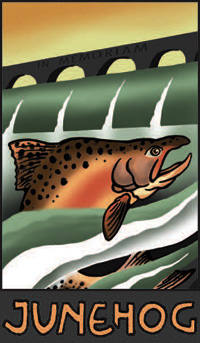 With Passover starting today and Easter a few days away, I should probably pick one or the other - or both - religious holidays to give a few wine pointers about. But today I'm inspired to go a different route; so if it was holiday wine you were hoping for my musings about, I hope instead you'll use this as an opportunity to get your own feet wet in your local shop (if you haven't already - tisk, tisk!) and see what your local buyer might recommend. (A Riesling or Gewurtztraminer for your Ham dinner, perhaps? Or maybe you're having lamb and need a dynamic red blend from the Cote du Rhone or even California? But I digress...)
We've been tasting a bunch of Pinot Noir again lately at the shop. (A tough job, but someone has to do it!) We usually get on the Pinot tasting wagon around the winter holidays because it pairs so well with Thanksgiving dinner and is often a special selection at Christmas. Well, it turns out we're at this crazy point in the year where two vintages are available: the 2006 vintage is still perfectly delicious, but the 2007's are starting to get a bit more of a 'push' from salesmen. Just this week Wine Spectator magazine reported the same thing via Monday's Tasting Highlights article. And so here I am telling my own tale in the very, very informal "battle of the Pinots".
With Passover starting today and Easter a few days away, I should probably pick one or the other - or both - religious holidays to give a few wine pointers about. But today I'm inspired to go a different route; so if it was holiday wine you were hoping for my musings about, I hope instead you'll use this as an opportunity to get your own feet wet in your local shop (if you haven't already - tisk, tisk!) and see what your local buyer might recommend. (A Riesling or Gewurtztraminer for your Ham dinner, perhaps? Or maybe you're having lamb and need a dynamic red blend from the Cote du Rhone or even California? But I digress...)
We've been tasting a bunch of Pinot Noir again lately at the shop. (A tough job, but someone has to do it!) We usually get on the Pinot tasting wagon around the winter holidays because it pairs so well with Thanksgiving dinner and is often a special selection at Christmas. Well, it turns out we're at this crazy point in the year where two vintages are available: the 2006 vintage is still perfectly delicious, but the 2007's are starting to get a bit more of a 'push' from salesmen. Just this week Wine Spectator magazine reported the same thing via Monday's Tasting Highlights article. And so here I am telling my own tale in the very, very informal "battle of the Pinots".
First, let's remember each vintage in each (sub)region of the world is unique. I recommend Googling various grapes and regions for vintage reports particular to a given year - and then reading a myriad articles for greater perspective on the lay of the land. Second, please, please remember good wine can be made in a bad year. That's what we call winemaker expertise. (Of course, pretty much anyone can make good wine in a good year.) Finally, each individual wine sings its own tune. So ultimately, you have to taste to know.
By point of reference, I found 2006 largely produced a solid batch of domestic Pinot Noirs. Of course there were some hits, some homeruns (go Pedroia and Varitek! ahem, sorry...) and some horrible misses. But for the most part, the wines are solid across the board. You simply need to know what style you prefer (ligher, earthier, meatier/fleshier, coca cola or beets, etc.) and ask your wine buyer which one is likely to suit your palate - but I argue 2006 Pinots largely don't suck.
The 2007s, on the other hand, struggled out of the gates last fall. It was a rainy year here in the States, with varying results depending on when the grapes were harvested and how badly the rains fell in a given (sub)appellation. When we started tasting through these wines in anticipation of Christmas last fall, many were a bit rough around the edges, still tight and green and a bit disjointed, showing very little fruit at all. We suspected they just needed some time to 'settle in' and would improve in as little as six months.
Wouldn't you know, it's been just about that time? Today, with some bottle time under its belt, the O'Reilly's Pinot Noir is more reminiscent of its fan-favorite 2006 counterpart; the Siduri '07 Pinots are absolutely sudductive; the '07 Dobbes Family Estates Assemblage Cuvee (and their less expensive offering under the "Wine by Joe" label) are solid, solid wines; and.... the list goes on!
This Wednesday I encourage you to get out and about and try your own grouping of Pinots from both vintage years (whichever part of the world you prefer) and see which strikes your fancy!
Have you had your own 2006 vs. 2007 Pinot Noir taste-off yet? Were they from the same vineyard, or different selections all together? Tell us your impressions!



 White wines aren't just a summer thang. (One of the best turkey wines is actually
White wines aren't just a summer thang. (One of the best turkey wines is actually  Perhaps like you, earlier this week I
Perhaps like you, earlier this week I  Last week here in Beantown the weather went from gorgeous fall to stormy insanity. In some ways this is a wine buyer's dream. There's no other time of year where you can pick wines for the weekly tasting to straddle the warmer/colder, sunnier/rainier line and scratch almost every consumer's itch. And since there's so much new juice on the market, we can also introduce our customers to new products. See? There's always a silver lining (even when you now have a natural swimming pool in the backyard...)!
But I'm jazzed about my topic for this Monday morning musing for another reason, too... remember last week we started talking about fall wine options? Well, for my white wine readers and
Last week here in Beantown the weather went from gorgeous fall to stormy insanity. In some ways this is a wine buyer's dream. There's no other time of year where you can pick wines for the weekly tasting to straddle the warmer/colder, sunnier/rainier line and scratch almost every consumer's itch. And since there's so much new juice on the market, we can also introduce our customers to new products. See? There's always a silver lining (even when you now have a natural swimming pool in the backyard...)!
But I'm jazzed about my topic for this Monday morning musing for another reason, too... remember last week we started talking about fall wine options? Well, for my white wine readers and